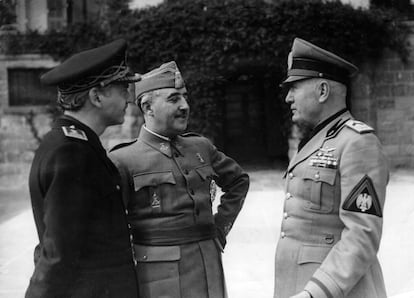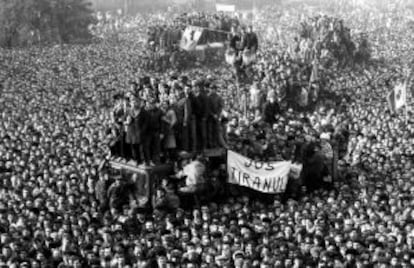The modern dictator’s handbook
A book by Frank Dikötter analyzes the common traits of 20th century despots

Benito Mussolini — Il Duce — gave away autographed photos of himself, often with personal messages. Hitler’s voice constantly resonated throughout a Nazi Germany plastered with images of the Führer. Stalin embodied not only the Communist Party, but also Grandfather Frost — Russia’s Santa Claus. Mao Zedong — China’s Great Helmsman — was the philosopher-king of the East. And François “Papa Doc” Duvalier was the first voodoo protector of Haiti. They all portrayed themselves as champions of the people, advocating for a fresh political approach while elevating themselves far above the masses. Like Machiavelli, they knew that it’s better to be feared than loved. However, they also craved adulation and wanted to cling to power forever, which led to repressive systems designed to maintain an illusion of popular support. These are some of the shared characteristics of modern dictators explored by Dutch historian Frank Dikötter in How to Be a Dictator: The Cult of Personality in the Twentieth Century.
Throughout the 20th century, millions of people hailed their dictators while suffering under brutally oppressive regimes. Their faces adorned billboards, buildings and even everyday products. With tight control over the press and education, these totalitarians were omnipresent figures on radio and television. Dictators basked in the adulation of their subjects parading in front of presidential palaces, carrying an assortment of objects, medals and emblems of support. The goal was to create the illusion of popular will. The cult of personality aimed to obtain obedience through isolation, by subjugating individuality to the masses. Steeped in superstition and magic, it became a type of top-down religiosity. Hitler portrayed himself as a messiah with a mystical bond to the German people. Duvalier stoked rumors of his supernatural powers. Communist countries discovered that elevating their leaders to sacred status yielded better results than promoting dialectical materialism, which most people did not understand.
In those dictatorships, loyalty to a single person held utmost importance because following a creed often led to divisions and factions. Mussolini rejected ideology and prided himself on following his instincts. Hitler wielded nationalism and antisemitism, but needed little else. Megistu in Ethiopia was inspired by Lenin, the creator of the revolutionary vanguard, rather than the ideological Marx. Stalin and Mao were worshiped for decades until they died of old age. Duvalier handed down power to his son, Baby Doc, who carried on his father’s cult of personality. Three generations of Kims in North Korea have enjoyed the worship of their pitiful people. But dictators beware — when fear vanishes, the illusion of ubiquitous love also vanishes. Romania’s Nicolae Ceaușescu delivered his traditional speech in front of the People’s Palace in December 1989. The speech was televised but the cameras didn’t show “spontaneous displays of unconditional support.” Instead, the world saw thousands of protesters swarming over the massive edifice. Ceaușescu and his wife would be dead by the end of the year after being tried and executed for economic sabotage and genocide.

Dictators with longevity successfully blend a cult of personality with terror. In the initial phase, the leader must exert enough influence to defeat opponents and attract public acclaim. The cult diminishes both allies and rivals, coercing their collaboration through submission. However, as these leaders mature, it becomes less clear who genuinely supports or opposes them. The dictator must then clean house through ruthless internal purges. The purge survivors and other visible faces of the regime become complicit in the regime’s crimes, ensuring the perpetuation of the cult of personality. To sustain terror, it’s crucial to maintain the illusion of a personal connection with the people.
Adolf Hitler, who early on discovered his ability to captivate the masses, meticulously crafted his public appearances until the very end. Hitler’s initial image campaign, orchestrated by Alfred Rosenberg when he turned 34, released press photos of his face over a black background. Mein Kampf served as both his political biography and his legend — the gifted child and artist, avid reader, born orator, and savior of the German people. Rather than erecting statues, he focused on his face and voice, which reached far and wide. Hitler was a chameleon who could read the mood of his audience and seamlessly absorb it into a meticulously rehearsed choreography performed at countless rallies and parades. When the German people learned of his death, a wave of suicides swept the country.
Vladimir Lenin, too, was glorified during his lifetime. Following his death in 1924, Josef Stalin positioned himself as Lenin’s most loyal disciple. Four years later, he initiated the first major purge of the Communist Party during the annual May Day parade. Instead of cementing a cult of personality, Stalin portrayed himself as the embodiment of the proletarian revolution. His carefully cultivated image of spontaneity was solidified during the Great Patriotic War (World War II). Once victory was achieved, he sidelined all the military men who challenged his glory. Shortly before his death, Stalin commissioned a large statue of himself to be placed at the confluence of the Volga and Don rivers.
On his 70th birthday, Mao Zedong celebrated alongside Stalin at the Bolshoi Theater in Moscow. Mao discovered his true calling in mobilizing China’s peasants, swiftly eliminating rivals and competitors along the way. While officially advocating for the Cultural Revolution, he assumed personal control over nearly every aspect of government, much like Stalin. Gradually, he transformed into a distant, almost divine figure, and retreated to the secluded Forbidden City of the emperors.
Throughout history, dictators have employed a range of tactics to consolidate power. They burned books, desecrated tombs, and demolished sacred sites, all in an attempt to rewrite the past and shape their own narrative. Through his examination of the origins and applications of modern authoritarianism, Dikötter sheds light on some unsettling aspects of life today. During these times of uncertainty and revisionism, we are seeing the ideological descendants of some of the 20th century’s most notorious despots emerge, people who rely on their self-made cult of personality and eschew genuine political engagement.
Sign up for our weekly newsletter to get more English-language news coverage from EL PAÍS USA Edition
Tu suscripción se está usando en otro dispositivo
¿Quieres añadir otro usuario a tu suscripción?
Si continúas leyendo en este dispositivo, no se podrá leer en el otro.
FlechaTu suscripción se está usando en otro dispositivo y solo puedes acceder a EL PAÍS desde un dispositivo a la vez.
Si quieres compartir tu cuenta, cambia tu suscripción a la modalidad Premium, así podrás añadir otro usuario. Cada uno accederá con su propia cuenta de email, lo que os permitirá personalizar vuestra experiencia en EL PAÍS.
¿Tienes una suscripción de empresa? Accede aquí para contratar más cuentas.
En el caso de no saber quién está usando tu cuenta, te recomendamos cambiar tu contraseña aquí.
Si decides continuar compartiendo tu cuenta, este mensaje se mostrará en tu dispositivo y en el de la otra persona que está usando tu cuenta de forma indefinida, afectando a tu experiencia de lectura. Puedes consultar aquí los términos y condiciones de la suscripción digital.
More information
Archived In
Últimas noticias
Venezuela authorizes the release of another 87 political prisoners
There is as much life left to discover on planet Earth as that which is already known
Dozens presumed dead, around 100 injured in fire at Swiss Alps bar during New Year’s celebration
Is porn for women different from conventional porn? We spoke to those who make it
Most viewed
- David King, chemist: ‘There are scientists studying how to cool the planet; nobody should stop these experiments from happening’
- Reinhard Genzel, Nobel laureate in physics: ‘One-minute videos will never give you the truth’
- Oona Chaplin: ‘I told James Cameron that I was living in a treehouse and starting a permaculture project with a friend’
- Sinaloa Cartel war is taking its toll on Los Chapitos
- The Interoceanic Train, the Mexican alternative to the Panama Canal










































